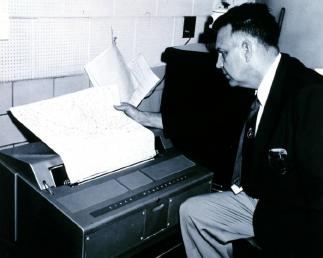POJ 3125 Printer Queue(打印队列---模拟)
来源:互联网 发布:怎么通过网络找客户 编辑:程序博客网 时间:2024/04/30 14:00
题目链接: http://poj.org/problem?id=3125
Printer Queue
Time Limit: 1000MS Memory Limit: 65536KTotal Submissions: 3082 Accepted: 1655
Description
 The only printer in the computer science students' union is experiencing an extremely heavy workload. Sometimes there are a hundred jobs in the printer queue and you may have to wait for hours to get a single page of output.
The only printer in the computer science students' union is experiencing an extremely heavy workload. Sometimes there are a hundred jobs in the printer queue and you may have to wait for hours to get a single page of output. Because some jobs are more important than others, the Hacker General has invented and implemented a simple priority system for the print job queue. Now, each job is assigned a priority between 1 and 9 (with 9 being the highest priority,
and 1 being the lowest), and the printer operates as follows.
- The first job J in queue is taken from the queue.
- If there is some job in the queue with a higher priority than job J, thenmove J to the end of the queue without printing it.
- Otherwise, print job J (and do not put it back in the queue).
Your problem with the new policy is that it has become quite tricky to determine when your print job will actually be completed. You decide to write a program to figure this out. The program will be given the current queue (as a list of priorities) as well as the position of your job in the queue, and must then calculate how long it will take until your job is printed, assuming that no additional jobs will be added to the queue. To simplifymatters, we assume that printing a job always takes exactly one minute, and that adding and removing jobs from the queue is instantaneous.
Input
One line with a positive integer: the number of test cases (at most 100). Then for each test case:
- One line with two integers n and m, where n is the number of jobs in the queue (1 ≤ n ≤ 100) and m is the position of your job (0 ≤ m ≤ n −1). The first position in the queue is number 0, the second is number 1, and so on.
- One linewith n integers in the range 1 to 9, giving the priorities of the jobs in the queue. The first integer gives the priority of the first job, the second integer the priority of the second job, and so on.
Output
For each test case, print one line with a single integer; the number of minutes until your job is completely printed, assuming that no additional print jobs will arrive.
Sample Input
31 054 21 2 3 46 01 1 9 1 1 1
Sample Output
125
Source
Northwestern Europe 2006
/*思路(yf):这个题思路很简单,就是运用的队列,主要是处理时费时间。要想清楚才行,比如说,第一个,从队列的front 看来是找到rear,如是没有比他大的就直接打印,time +=1;判断这个点是不是标记的那个点,如果是,则直接输出time ,如果不是就向后走,还有需要注意的就是,如果是找到那个要打印的那个点,如果不能打印,那么这个标记打印的数也要跟着变化,主要就这两点吧代码:*/#include<iostream>#include<stdio.h>using namespace std;int main(){int a[10010];int front,rear,i;int cases,n,d,time,ok;scanf("%d",&cases);while(cases--){front=0;rear=0;time=0;ok=0;scanf("%d%d",&n,&d);for(i=0;i<n;i++){scanf("%d",&a[i]);rear++;}while(front<=rear){for(i=front;i<rear;i++){if(a[i]>a[front]) {a[rear++]=a[front];break;}}if(i>=rear) {time+=1;if(front==d){printf("%d\n",time);ok=1;break;}else front++;}else if(front==d) {d=rear-1;} else front++;if(ok) break;}}return 0;}- POJ 3125 Printer Queue(打印队列---模拟)
- POJ 3125 Printer Queue【简单模拟a打印队列】
- POJ 3125 Printer Queue 模拟队列
- POJ 3125 Printer Queue(用队列模拟过程)
- uva 12100 Printer Queue(打印队列)模拟
- poj 3125 Printer Queue (队列)
- POJ 3125 && Sicily 1443 Printer Queue(模拟/队列)
- POJ 3125 && Sicily 1443 Printer Queue(模拟/队列)
- Printer Queue打印队列
- 打印队列(Printer Queue)
- Printer Queue(打印队列)POJ3125
- Printer Queue(poj3125模拟队列)
- POJ 3125 Printer Queue 数据结构 队列
- UVa12100 Printer Queue (打印队列)
- UVA12100:Printer Queue(打印队列)
- poj 3125 Printer Queue
- POJ 3125 Printer Queue
- Printer Queue(poj 3125)
- pythonPkg_BeautifulSoup
- dom解析xml
- 家庭理财 数据库的设计
- 第八章 复杂数据类型与指针
- Net类型设计准则
- POJ 3125 Printer Queue(打印队列---模拟)
- spring2.5.6下配置定时器
- poj1579 Function Run Fun
- POJ 1840 Eqs(简单hash入门)
- ORC 2V2 详细心得
- 第10章 网络编程 08_总结
- WWDC 2012 Session 221 iOS User Interface Design (iOS 用户界面设计)
- QML范例详解
- 再读《The C Programming Language》 - 第一章 1.6 数组


